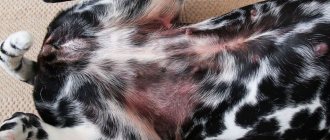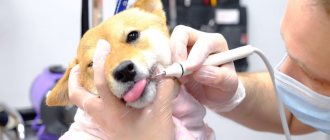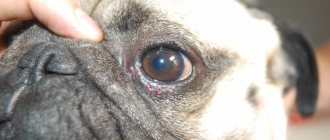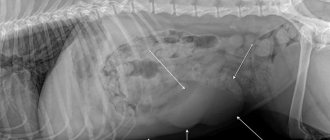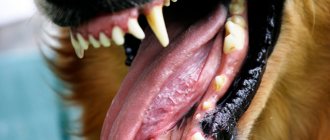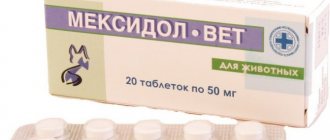Common Causes of Paw Swelling
Below we will explain in detail what the most common causes of inflammation of the limbs are. Before we begin, we need to note that all causes require veterinary treatment. They are:
- abscesses,
- joint injuries,
- calluses,
- fractures,
- swelling,
- tumors.
I suggest you take a closer look at each of these reasons. Below, read in detail and briefly about all six causes of paw swelling in dogs.
The dog has a swollen paw pad: mechanical damage
Soft tissues on the paws cushion them and provide the pet with tactile sensations when walking. Delicate pads are often injured from external factors, both through the fault of the pet itself and the owner. Paw pads can become swollen from:
- insect bite - wasp, bee, even mosquito;
- puncture wound from glass or other sharp object;
- bruise.
In any case, the wound must be disinfected and covered with a bandage; if it was a targeted bite, you can leave it to “breathe.” A dog's paw that is swollen after a bite is not a reason to worry if there are no alarming signs of shock. After 2 days it will subside; for prevention it is recommended to give an antihistamine.
Abscesses
An abscess is a collection of pus under the skin. It can appear after an injury caused by a bite, scratch, or any foreign body that has become stuck and lodged in the paw.
In these cases, the skin appears healed, but an infection has developed underneath and accumulates pus. This is called an abscess. It usually occurs in one limb.
Sometimes the abscess opens and pus begins to ooze out. However, it also happens that the pus does not come out completely. In these cases, the veterinarian will have to drain him, thoroughly clean the area, and prescribe medications if necessary.
Joint injuries
Sprains and strains can happen at any age and for reasons such as poor movement, a fall or a blow. There are also some diseases, such as borreliosis, that include joint swelling among the symptoms. But, in any case, this inflammation is not always visible.
In fact, a common sign would be lameness and more or less obvious pain.
Additionally, older dogs may have degenerative joint diseases that cause stiffness, pain, and inflammation. They may not heal, but quality of life is improved and pain is reduced with treatment recommendations. Veterinary evaluation is always necessary to determine the cause.
Neoplasms of fingers in dogs and cats
general information
Tumors of the fingers, unfortunately, are a fairly common pathology in animals. This problem occurs less frequently in cats than in dogs.
According to statistics:
- 61% of finger tumors are malignant;
- 20% are benign formations and 19% are due to pyogranulomatous inflammation;
- 12% of all inflammations of the claws and claw bed turn out to be tumors.
Digital neoplasms include squamous cell carcinoma (33%-54%), malignant melanoma (11%), soft tissue sarcomas (9%), and osteosarcomas (6%). Mastocytomas, epidermoid cysts, plasmacytomas and, quite rarely, calcifications also occur.
Diagnostics
The most accessible visual diagnosis for finger tumors is an x-ray examination of the limb. Most often, the radiograph shows osteolysis (melting/decrease in the radiographic density of the bone). 83% of cases of malignant tumors of the fingers are accompanied by bone lysis.
Among benign formations, intraosseous epidermal cysts and infiltrating lipomas can lead to osteolysis.
Neoplasms and non-neoplastic processes that may be accompanied by a significant increase in soft tissue volume, but do not lead to bone lysis, include mastocytomas, plasmacytomas, soft tissue sarcomas, adenomas/adenocarcinomas of the sebaceous glands, histiocytomas, papillomas and calcifications.
Formations affecting mainly:
- one finger – plasmacytoma, soft tissue sarcoma, osteosarcoma, squamous cell carcinoma;
- finger and part of the tarsus/wrist – synovial sarcoma and adenocarcinoma;
- several fingers – synovial sarcoma, squamous cell carcinoma, plasmacytoma.
The average age of the patient is 9 years, no gender predisposition has been identified. In this case:
- 75% of cases are large dogs;
- 67-71% are dogs with black fur.
A morphological examination – cytological/histological – allows one to accurately differentiate a malignant and a benign tumor.
The most common malignant neoplasms of the fingers
Squamous cell carcinoma of the finger
- Originates from squamous epithelial cells
- Solitary ulcerated, often bleeding lesion
- Cases of multiple squamous cell carcinoma of the fingers have been reported in Giant Schnauzers.
- Rarely metastasizes
- In 80% of cases it invades the bone
Treatment is most often surgical - amputation of the finger.
Melanoma
- 50% benign pigmented nevi, 50% malignant melanoma;
- Melanocytic nevi do not recur or metastasize after surgical treatment;
- Bone lysis is detected in 5% of cases of finger melanoma;
- The prognosis is very guarded due to the high rate of development of distant metastases;
- Local recurrence occurs in 14%-30%;
- Metastasis to regional lymph nodes and lungs in 58%-71% of cases, of which 32% already at the time of initial diagnosis.
Survival rate within 1 year – 42%-66%, within 2 years 12%-22%, with therapy
Mastocytoma
- The biological behavior of finger mastocytoma, as a rule, corresponds to stage III skin mastocytoma;
- Survival rate within 1 year is 88%, within 2 years – 50%.
Osteosarcoma of the finger
- Treatment is amputation of the finger followed by chemotherapy;
- Average life expectancy is 466 days with euthanasia due to the development of metastatic disease;
- The prognosis for osteosarcoma of the finger is better than for osteosarcoma of other parts of the extremities;
- Surgical removal distal to the carpus/tarsus results in an excellent prognosis in humans.
Other finger tumors
Tumors of the fingers in cats are most often associated with digital pulmonary syndrome, with adenocarcinomas and squamous cell lung cancer, and also occur with squamous cell skin cancer.
Tumors of the exocrine glands of the skin of the fingers are also rare. May be accompanied by lameness and swelling of the skin/soft tissue of several fingers. Adenocarcinoma is the most aggressive of the glandular tumors found in this location. It is also accompanied by bone lysis. Tends to metastasize to regional lymph nodes and lungs.
New growths of the fingers require careful diagnosis, since the treatment of various pathologies can differ radically. Early diagnosis can significantly improve prognosis and possibly avoid aggressive therapy.
Veterinary oncologist at SVK “Svoy Doktor” f. Dzerzhinsky Kalevskaya Ya.F.
Calluses on paws in dogs
Also called herpes. They are grayish in color without hardness with folds that appear where the bone presses against the ground when it is a hard surface. It most often affects heavy dogs or those living in kennels with concrete floors .
The affected area is usually the elbow joint, then the joints, and buttocks. They can become infected and require veterinary treatment. To prevent herpes, you need to place your dog on soft surfaces.
It is the inflammation of the bursa, sacs filled with synovial fluid, that protect the joints. They may appear on one or both elbows. They usually don't hurt or affect movement, but like calluses, they can become infected. The veterinarian will treat them with a bandage, drainage, surgery, or medications.
Leg fractures
When a bone breaks, it can result in an open or closed fracture. In the first case, we will see a wound, and in the second, the skin will remain intact. In both we can detect inflammation. Limb fractures are caused by blows, a strong blow, or a fall from a great height.
In these cases, the dog is likely to suffer more damage, such as internal bleeding, organ trauma, and the like. Therefore, a thorough check by a veterinarian is required. You should see a professional for evaluation, management, and treatment of your pain. This may be immobilization or surgery.
Treatment of pododermatitis at home
Treatment for pododermatitis varies depending on the underlying cause:
- parasitic infestations are treated with antiparasitic shampoos, tablets, injections;
- infectious diseases require long-term use of antibiotics or antifungal drugs;
- foreign bodies are removed from the paws by minor surgical treatment;
- hormonal diseases will require a long, possibly lifelong course of hormonal medications;
- Allergic pathologies are treated by eliminating the allergen.
Conformational pododermatitis is the most difficult to cure, since the defect is caused by the shape of the patient's foot. In all cases, along with the main treatment course, you will need to maintain foot hygiene and avoid walking on rough terrain.
Important! Pododermatitis is characterized by periods of remission followed by exacerbation. Therefore, be sure to check with your veterinarian what and how to do at home in case of exacerbation of the disease.
Treatment for atopic form
Atopic is a disease of allergic origin that the patient will suffer from for life (chronic form).
The causes of allergies vary, but the symptoms are the same:
- itching;
- pale pink rashes on the skin;
- rash located in the bends of the joints;
- peeling, redness, cracks in the skin.
Treatment of allergic dermatitis in dogs:
- "Apoquel" - 0.4–0.6 mg/kg 2 times a day for 2 weeks. The drug is designed to quickly relieve itching and reduce skin inflammation.
- Oclacitinib is an immunomodulator. The dosage and duration of the course are prescribed by the veterinarian depending on the condition of the pet.
- “Prednisolone” - 1 mg/kg 1 time per day for a week, and then every other day for 2 weeks for accelerated healing.
- Constantly treat the paws with an antiseptic and lubricate them with “Ichthyol ointment.”
How to treat the bacterial form
Fungal infections often cause pododermatitis in dogs.
This:
- yeast fungi of the genus Malassezia (Malassezia dermatitis);
- dermatophytes (dermatophytosis);
- various bacteria (interdigital pyoderma).
Yeast is always present on the skin. But if the immune system weakens, they begin to develop more actively. The disease manifests itself as itching, alopecia, peeling, swelling and the smell of rotten fish. Malassezia fungi affect not only the skin, but also the claws. They also change the color of the coat - in light breeds it becomes much darker in the affected area.
Medicine for Malassezia dermatitis is prescribed for life. Paws should be washed with shampoos containing azoles (Miconazole, Clotrimazole, Triclosan). Treatment - Ketonazole 5-10 mg/kg 1-2 times a day for 3 weeks.
Important! For weeping wounds, use Tsamax powder instead of ointment. Apply it to the surface treated with an antiseptic in a thin, even layer and cover the wound with a bandage.
Dermatophytosis appears not only on the paws, but also on the face. These are keratinized, thickened areas of skin on which hair has fallen out. The claws are not affected by this disease. Treatment will be prescribed comprehensively and will be accompanied by disinfection of the premises, bedding, and enclosure.
Interdigital pyoderma is accompanied by cysts in the interdigital spaces, swelling, ulcers, and deformation of the pads. Wounds look like suppuration when a foreign body enters. They get wet and are very painful. Treatment will consist of a long course of antibiotics. In some cases, surgery will be required to remove interdigital cysts.
Drugs used:
- "Amoxicillin" - 22 mg/kg 2 times a day;
- "Clindamycin" - 11 mg/kg 1 time per day;
- "Cefalexin" - 22 mg/kg 2 times a day.
Edema in dogs
Edema is an accumulation of fluid that becomes visible in areas such as the abdomen or limbs. These accumulations occur as a consequence of certain diseases, such as renal failure, congestive heart failure.
Edema occurs due to problems with fluid removal, poor diet, or low levels of protein in the blood. Swelling can affect all four legs. It requires veterinary treatment because the cause must be determined and specific treatment prescribed.
Diuretics are usually prescribed to help remove excess fluid. These are medications that should always be used under the supervision of a veterinarian.
The dog's paws are swollen
If your dog's paws are swollen
, many pet owners are starting to sound the alarm as they begin to suspect the worst.
In fact, there are many reasons that can lead to such a symptom. Many of them are not dangerous and only require a long rest. That is why it is necessary to first calm down and analyze how the animal’s day went and what could have caused the dog’s paw to be swollen
.
Natural causes
First of all, do not forget that the dog’s body is in many ways similar to the human body. Excessive accumulation of fluid in the paws can be the result of a long and tiring walk without prior training. Such loads should be gradual.
Naturally, older animals need special care. Their leg swelling may be accompanied by some kind of internal disease. When walking older pets, it is recommended to focus on the dog’s condition - if it wants to go home, then it’s time to stop walking.
Swelling of a dog's paws as a symptom of the disease
If your dog's back legs are swollen
not only after a walk and the swelling does not subside after rest, then you need to contact a veterinarian, because such a symptom is a sign of many diseases, such as:
- Reduced oncotic pressure caused by a lack of proteins. In such a situation, it is necessary to change the pet’s diet, enriching it with protein foods.
- Heart or kidney failure. It can only be treated with medications.
- Stopping veins from blood clots, which causes poor blood flow.
- Swelling resulting from poisoning or an insect bite. As a rule, it is accompanied by other symptoms - vomiting, fever, etc.
Animals often injure their paws. In the veterinary clinic, after all procedures have been completed on the injured paw, a bandage is applied to it. If your dog's back leg is swollen
near the bandage, this may indicate pinching or compression of the veins. In this case, you need to remove or simply loosen the bandage as soon as possible to restore blood flow in the paw.
Tumors in dogs
Tumors are abnormal growths of cells that can occur in various parts of the body. Some are benign and others are malignant and have the ability to spread to other places in a process called metastasis.
They can grow in a variety of cells, including bone cells, causing inflammation in the affected limb. Whenever we suspect the presence of a tumor, it is important to go to the veterinarian as soon as possible, as it is necessary to obtain an early diagnosis.
This is what guarantees the best chance of success in treatment. To know whether it is cancer or not, the veterinarian will remove the tumor or take a sample to send to the laboratory. In this way, basic information is obtained to identify the type of cancer and the extent to which it is detected. Treatment and prognosis depend on this.
First aid if your dog has a swollen toe
The place on the paw between the toes is characteristic of the formation of histiocytoma. This is a benign tumor of the skin, blood vessels and connective tissue. It occurs in all breeds, but smooth-haired breeds are more prone to it.
Host actions
Usually, if a dog’s paw is swollen between the toes due to a histiocytoma, there are no other symptoms other than the formation itself. The pet does not feel pain, eats well and plays. Over time, it can cause inconvenience when walking or spoil the aesthetic appearance. Before visiting the veterinarian you need:
- protect the tumor from moisture, incl. and from licking;
- do not injure the histiocytoma;
- Cover with a comfortable, breathable bandage.
Treatment Options
Small tumors are smeared with Triderm 2 times a day. Additionally, immune-supporting therapy is prescribed. Large ones are excised by surgery. The danger of histiocytoma is the transition to a malignant formation, therefore tissue examination is indicated. High risks of cancer in older dogs: then chemotherapy or radiation is prescribed.

